FineMolds
1/350 Imperial Japanese Navy Destroyer Ayanami, Kit #FW1

Reviewed by Dan Kaplan

BACKGROUND |
||
|
The Fubuki type destroyer (known as the Toku-gata, or Special Type, in Japanese naval parlance) was revolutionary in naval design, given its greater size and armament versus other naviesí destroyers at the time of its introduction in 1929. The design packaged three twin 5 inch mounts in enclosed turrets, a heavy battery of nine 24Ē torpedoes with reloads, long range and a high speed in a powerful package whose destructive broadside outmatched anything comparable, including most naviesí light cruisers. Ship specifications and a reasonably accurate background on the class are available in our CASF Fubuki thread on the Modelwarships.com forums. Ayanami (pronounced Aay-ah-nom-me) was the lead ship of the ten units that comprised the second group of this design, referred to as the Type IIs. She was laid down on January 2, 1928 at the Fujinagata Shipyards in Osaka, Japan and commissioned on April 30, 1930. As with others of her class, Ayanami underwent modernization in the mid 1930s. She had an active and notable war record in Chinese waters in the late 1930s, and then in the South Pacific until sunk at the 2nd Naval Battle of Guadalcanal on the night of November 15th, 1942. One of the 3 ships of DesDiv 19 led by light cruiser Sendai that night as part of the escort for the IJN bombardment force, she was detached for a solo scouting sweep around the west coast of Savo Island. There, she ran into a US force comprised of battleships South Dakota and Washington, proceeded by their four destroyer escort. In conjunction with other IJN ships, her gunfire and torpedoes contributed to heavy damage among all four of the American destroyers; one of her torpedoes likely the one that hit and doomed USS Walke. In turn, she was taken under fire by Washington and severely damaged. Immobilized, she was later scuttled by a torpedo from her sister Uranami. Her remains were discovered in 1992 by the famed Ballard expedition while searching for warships sunk during the Guadalcanal campaign. KITAfter a very long gestation period, the FineMolds 1/350 Fubuki class destroyer Ayanami kit was released in December, 2010 to great fanfare in Japan. The fourth IJN destroyer kit in this scale molded in styrene plastic and released to date, it is the best so far in my estimation, given the fineness and level of detail offered. It also ranks as the best 1/350 kit Iíve yet seen, but then again, most of what Iíve seen in 1/350 is IJN. This is the first 1/350 ship kit to be released by FineMolds. According to a note on their website as of this writing, a second production run is scheduled for release in mid February, 2011. Straight out of the box, this kit can be built as one of the first five of the ten Type II ships (Ayanami, Shikanami, Sagiri, Amagiri, or Asagiri.) Some minor modifications would be required to build the kit as one of the other five Type II units (Yugiri, Akebono, Oboro, Sazanami, or Ushio). The fit out-of-the-box is immediate pre-war and early war fit through the end of 1942. The kit is molded in light grey & red plastic, with both a waterline option plate and the underwater portion of the hull for a full hull option. Details are very sharply molded. All the kit surfaces have a nice matt finish. On my kit, there was a hint of flash on some parts and just a few, very shallow sinkholes on a few of the smaller ventilator surfaces, though nothing that canít be easily corrected. The kit sprues are arranged in an almost identical manner to that of the Tamiya Yukikaze, and the styrene plastic color, consistency and finish is identical to that of Yukikaze. A comparison between kit parts also reveals that some details, such as the jackstaffs, appear to be identical, giving some credence to the rumor that Tamiya provided backing and support for the project. That said, a great many of Ayanamiís parts are molded to a higher level of detail than the Yukikaze. One quick example is the difference between the two kitís respective 7.5 meter launches. A far higher a level of detail has been achieved in the FineMolds version by offering three piece construction including a somewhat detailed interior with an optional canvas topped covering, vs. the two piece, fully enclosed version from Tamiya. The sprue breakdown, with sporadic comment, is as follows: |
||
| SPRUE A | ||
|
This sprue contains the underwater portion of the hull, bilge keels, waterline plate, 2 propeller brackets and rudder. Itís molded in a dark red plastic. The details are subtle; the underwater hull has molded grillwork for the sea intakes, and the rudder shows what I believe are small counterweights. A cap is included to allow the rudder to turn. |
||

|
||
| SPRUE B | ||
|
This sprue is comprised of the aft deckhouse, the torpedo stowage compartments with nicely detailed hatches, one set of upper funnel halves, various girder components of the three different sets of torpedo reload truss supports (mostly the upright columns), the aft emergency steering station, the RDF compartment, assorted air intakes, vents and piping, and the props. |
||
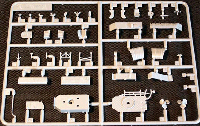 |
||
|
||
| SPRUES C | ||
|
This sprue contains the above waterline portion of the hull. Itís molded in two halves with 4 rigid inner trusses for hull support. Each truss is molded with a complete upper and lower portion that can be separated for use to support a waterline version of the hull. A plastic stand to support the full hull version also comes on this sprue. The hull has nicely scaled, alternating longitudinal bands to replicate hull plating and a correctly formed, slight concavity to the hull sides that are unique to this class. All portholes have fine eyebrows. There is no degaussing cable, which is sold separately as an aftermarket PE set by FineMolds. Alternatively, one can be made from styrene strip. Dimensionally, the hullís overall length measures 338.5mm (including the prow piece, part B33), which scales out to 118.48 meters/385 ft., versus the official OAL of 118.4m/384.8ft. Maximum width was approximately 30mm, which scales out to 10.5 meters/34.12ft., versus the official beam of 10.4m/34ft. Assuming my measurements are correct, the kit is pretty much on dimensional target. |
||
|
||
| SPRUE D | ||
|
Among the many components on this sprue are the two piece deck Ė forecastle and main deck, another set of upper funnel halves, both lower funnel assemblies, the funnel air intake skirts, sections of the bridge, small decking bits like the base under the #1 torpedo mount, and the remainder of the torpedo reload gantry trusses. The deck is finely molded with fine steel treading patterns and linoleum tie-down strips. Thankfully, molded on fittings are few aside from torpedo trolley and mine rail tracks as fittings are provided for separately. Equipment boxes are nicely molded on. The detail work on the torpedo girders and trusses is superb. For absolute realism, the upper trusses have round drain holes that can be drilled out; the vertical columns have triangular recesses that really cannot be drilled out but, are certainly deep enough to accommodate a wash for shading. Given the square cross-section of these truss pieces (the approximate equivalent of .02Ē x .02Ē square styrene strip), itís probably unlikely that a PE set will be produced in the near future, though it could be done with folded sections, much the way IJN carriers masts are done in 1/700 PE. |
||
 |
||
|
||
| SPRUES E & L | ||
Sprue EThis small sprue contains auxiliary funnel piping, the galley pipe, various bridge level braces, amd jackstaffs. Sprue LAnother small sprue, it contains both the forelegs of the foremast and the mainmast as well as the rear leg assembly of the foremast. Each has some nicely detailed joints where the connective bracing goes. Note that the foremast is molded only with the lowermost brace, the upper braces with have to be added by the modeler on their own. Most admirably, FineMolds has correctly molded the rear legs of the foremast with the lower portion of each leg slightly splayed out. This is another one of those details that is not noticed by most IJN DD fans, and ignored completely in the 1/700 scale versions. |
||
|
||
| SPRUE G | ||
|
This is a one piece sprue consisting of the bridge roof and windows, molded together in one clear piece of plastic. I find this choice quite puzzling. I would have expected the bridge windows to have been molded separately in clear plastic, as in the Yukikaze kit, among others. Here, it has to be masked to prevent paint overspray of gray for the bridge roof, or removed completely to permit PE ladder to be used to depict open windows. Iím sure there was a reason for this choice but I cannot discern it. |
||
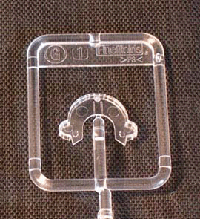
|
||
| SPRUES Vx2 | ||
|
It contains vents, several hawser or cable filled reels of different diameters, life preservers, two solid halves for the athwartships depth charge rack, and the funnel grills. I have to say that these are the finest set of funnel grills Iíve yet seen rendered in plastic. They are open to a far greater degree then Iíve seen before, with the only limitation a slight lack of open depth as seen from the side at a point directly opposite the base. Would PE versions work better? Yes, of course, but I think I could live with these if I had to. On the other hand, the depth charge rack is a disappointment of sorts, though the side framework is nicely detailed. In fairness, the other, previous IJN DD kits havenít faired any better. Given the great attention to detail in this kit, I wonder if FineMolds would not have been better served by offering a small fret similar to the one Tamiya supplies with Yukikaze, albeit with a depth charge rack as one of the offerings? |
||
|
||
| SPRUE Xx2 | ||
|
This sprue is comprised of the components that make up the Type 90 shielded torpedo mounts. Each sprue contains two triple mount housings in 4 pieces, tubes and torpedo warheads. Three are needed for the kit. Thereís the mount base, a base pair of torpedo tubes with a third, center tube that gets mounted between them at a slightly higher position, a 4 piece outer housing with fine detailing, and the forward third of the 24Ē torpedoes that gets glued to the underside of each tube in an exposed position. All the tube mounts are designed to be secured with hidden caps to allow turning. Iíve always thought this was a nice feature to have. |
||

|
||
| SPRUE Yx2 | ||
|
This sprue contains nicely detailed components that make up the main 12.7cm/5Ē battery. There are two turrets per sprue, each comprised of 4 pieces. There are also two sets of barrels, with canvas blast bags for each barrel. One set of barrels is posed in typical, level position; the other is posed as if raised to maximum elevation. As with the torpedo mounts, all the turrets are designed to be secured with hidden caps to allow turning. Most unexpectedly, each sprue contains two different turret models, contradicting a long-standing assumption of mine that the final version of the actual turret, the B2 model (the one with round vent holes on the turret sides and stiffeners on the sides), was used for all three mounts. Apparently, this is not so. I was forced to go back to my references to double-check. This is not easy because there just arenít that many clear, detailed photos of #s 2 & 3 turrets of the Fubuki class units from the immediately prewar and early war periods. (The #1 turret was not upgraded to B2 status until immediately prewar.) Fortunately, there are high quality photos of Sagiri and Sazanami in 1940 that confirms this mix of turret models. Which means that #s 2 & 3 turrets remained B1 models (horizontal vent inlets and no stiffeners on the sides). I have to give major kudos to FineMolds for this high degree of accuracy and for challenging my assumptions. They could easily have opted to provide one type of turret with almost no one the wiser. This is another example of the sort of detail exhibited throughout the kit that shows how high the base has been raised, |
||

|
||
| SPRUE WZx2 | ||
|
This sprue carries the ships boats and davits. Each carries a 7m cutter, two 7.5m motor launches, canvas cover, one pair of davits that were used forward to carry the cutters, a different pair of larger davits meant to carry the launches, a set of oars, one torpedo davit and one depth charge davit. These last two davits were designed to be collapsible but both are molded in the erect position. The detail here is extraordinary. The larger set of davits had circular lightening holes that can be drilled out for better effect. As mentioned earlier, the launches have inner details that can be exposed or hidden. This set is also sold separately as part of FineMolds new WZ line of 1/350 aftermarket equipment parts and it is the best detailed among those offering boats and davits. I think these offerings are a very smart marketing decision on the part of FineMolds to maximize the potential of the kit. (Photography credit: the photos of all four aftermarket accessory sets were taken from the FineMolds website.) |
||
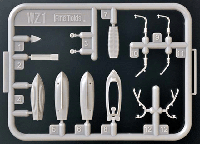
|
||
| SPRUE WZ2 | ||
|
Molded in clear plastic, this tree carries the port and starboard running lights, a 90cm searchlight with two different covers, two 2kw daylight lights, and two 30cm signaling searchlights. Again, the detail is extraordinary. This set is also offered as an aftermarket item. |
||
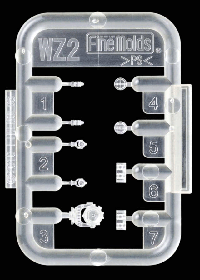
|
||
| SPRUE WZ3 | ||
Sprue WZ3Ax2This sprue contains finely detailed optical equipment such as podium mounted 12cm search binoculars, a gyrocompass binnacle, etc. Yet another set also offered as an aftermarket set in conjunction with set WZ3B Sprue WZ3BContains 2 each of a 3m rangefinder sited on top of the bridge for the main battery and a 2m rangefinder used for the torpedo battery. It also contains an RDF antenna with loops. This last item is nicely rendered but a little thick. A PE or brass rod version is a better scaled alternative, in my opinion. |
||
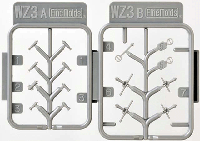
|
||
| SPRUE WZ4 | ||
|
This unit contains the light AA for the kit. Included is one quad 13mm mount, two twin 13mm mounts, 4 single pedestal mounted single 13mm mounts, one 12.7mm machine gun and one 7.7mm machine gun. Detail is superb. Another aftermarket set as well. This is a particularly welcome set as, to my knowledge; these are the only 13mm offerings in 1/350 to date. |
||
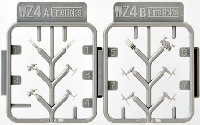
|
||
| DECALS AND MISCELLANEOUS | ||
|
Black anchor chain for the bow anchors, caps for the turrets and torpedo tube mounts Surprisingly, the decal sheet only contains several sets of Plimsoll markings for load. I say surprising because additional decals indicating her division number (19) and hiragana identification writing for her hull sides could have been included for completeness sake. These would have been entirely appropriate for the prewar period, given the fit, and that the kit comes without a degaussing cable. In fact, it would have been appropriate even with a degaussing cable for the latter part of 1941. |
||
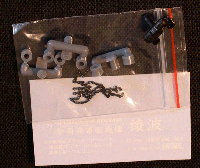
|
||
| INSTRUCTIONS | ||
|
The 16 page instruction pamphlet is clearly illustrated, though mostly in Japanese. Sub-assemblies are shown in great detail, and the construction process appears straightforward. The painting guide is keyed to the GSI Creos ďMr. ColorĒ and Tamiya paint lines. Interestingly, there is a small box on the second to last page that has a sprue replacement listing, with costs, for all the sprues. |
||
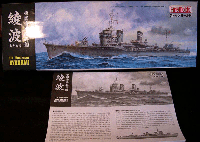
|
||
| CONCLUSIONS | ||
|
For fans of the IJN, of destroyers in general, or just new 1/350 kits, this is a must have kit that can satisfy the interest of novice or experienced modeler alike. Clearly, extensive research and engineering went into creating this kit as errors are non-existent, while detail and quality are at an extremely high level. Fit is yet to be determine but, I would strongly suspect few issues, if any, Hopefully, this kit will see great success and allow for other variants and fits to be issued for this very important class of destroyer. |
||
